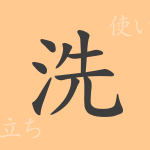The kanji “浅” (あさ), frequently used in everyday life, is steeped in deep meanings and history. This article explores the kanji “浅,” from its origins to its meanings and uses, including idioms and proverbs that illustrate its allure. By reading this, you will deepen your understanding of “浅” and enhance your grasp of Japanese.
Origins of 浅
The kanji “浅” has long been used to describe a state where water is not deep. Originating in ancient China, this character combines “氵” (さんずい), the radical for water, and “戋” (せん), which depicts the blade of a sword, symbolizing the sound. This combination gave birth to the fundamental meaning of “shallow water,” which has been adapted to various contexts over time.
Meaning and Usage of 浅
Primarily, “浅” is an adjective describing shallow water, but it is also used metaphorically. For example, it can express a lack of depth in knowledge or experience. Additionally, it is used to indicate lightness in color or mildness in flavor, signifying something minimal or slight.
Pronunciation, Stroke Count, and Radical of 浅
Understanding the pronunciation and structure of “浅” is essential.
- Pronunciation: The on’yomi (Sino-Japanese reading) is “セン”, and the kun’yomi (native Japanese reading) is “あさ.い” and “あさ-“.
- Stroke Count: “浅” consists of 9 strokes.
- Radical: The radical of “浅” is “氵” (さんずい).
Idioms, Phrases, and Proverbs Using 浅
There are numerous idioms and phrases involving “浅”. Here are some examples:
- 浅学非才 (せんがくひさい): Describes someone with superficial knowledge and lack of talent.
- 浅薄 (せんぱく): Pertains to having shallow knowledge or thoughts, lacking depth.
- 一瀬を浅くする (ひとせをあさくする): A metaphor for knowing something only superficially.
Conclusion on 浅
This article has allowed us to encounter the multifaceted charm of the kanji “浅”. From its basic meaning of shallow water to its metaphorical use in describing the depth of knowledge or emotions, “浅” is widely utilized in Japanese. Use this information to enrich your everyday language use.

























